Advanced Cavity dental- Root Restrate | Surgery.
Hello Community and all the people who read this article, I am very excited to write for you one more time! In this opportunity I will present a Real Clinical Case that I selected especially for you.
Dental cavity Advanced - Root Restrate | Surgery.
Well, I'll start by defining dental cavity:
"The World Health Organization (WHO) has defined dental caries as a localized process of multifactorial origin that begins after tooth eruption, determining the softening of the hard tissue of the tooth, which evolves until the formation of a cavity. 1"
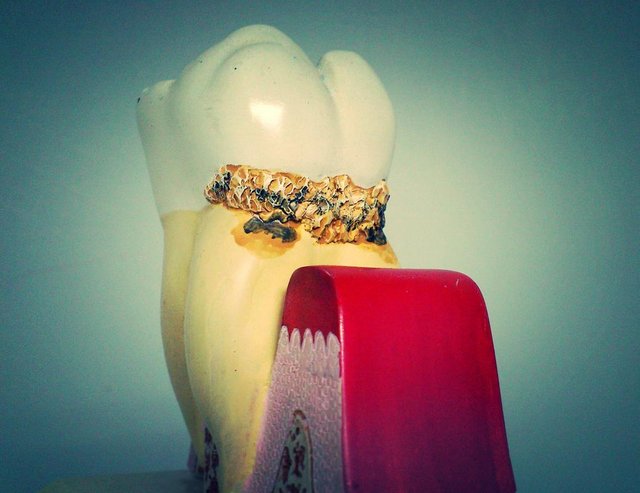
Ceramic model, To show patients in their dental appoinment. Autofoto @Ysabelbencomo
Ethology of the Cavity Dental.
1-- Dental anatomy:
There are 4 types of dental groups; incisors, canines, premolars and molars, these have different shapes, sizes and anatomical features. The posterior teeth are more susceptible to the appearance of caries because of their location and morphological surface, because they have pits, fissures, grooves and characteristic points where the food can easily lodge and accumulate bacterium.
Time:
The food remaining generate dental plaque which is colonized by microorganisms that produce acids that destroy the tooth, however time is a determining factor for this to happen, and is a fundamental part in the ethology of Dental Cavity. A tooth is able to withstand 2 hours per day of demineralization without suffering damage to its enamel, saliva has a buffer component in this phenomenon but tooth brushing provides this protection. 3

Diet:
The fermentable carbohydrates in the diet promote the appearance of caries, unlike the starches that do not produce it. But it is important to know that there is a process where carbohydrates are metabolized by an enzyme that produces the saliva called amylase, capable of converting to harmless starch in maltose and depending on how long the person remains without brushing, this could turn into glucose, decreasing the salivary pH and causing enamel demineralization. The persistence of a pH below 7 eventually produces the demineralization of the enamel.

*Bacterium *
They are those microorganisms that have the capacity to adhere to the acquired film and when they accumulate they form a "biofilm", forming a community of evading bacteria the host defense systems. The first bacteria to appear are gram positive with little capacity to form organic acids, but due to anaerobic conditions they are replaced by gram negative bacteria and that is when the cariogenic bacterial plaque is produced. The bacteria adhere to each other but a primary colonization by Streptococcus Sanguis belonging to the family of the Mutans is necessary, besides Lactobacillus acidophilus, Actinomyces naeslundii, Actinomyces viscosus, etc. 5

After carefully explaining these basic points, I would like to explain the Clinical Case:
Patient: Name: Reserved.
Age: 49 years
Sex: Female
Family Background: Not relevant.
Reason for dental appointment: Patient attends consultation presenting toothache in unit 17 and healing of fistula in unit 35 without pain on palpation.
Clinical examination:
Patient partially edentulous, with presence of amalgam restorations in good condition. Poor oral hygiene and abundant bacterial plaque.
Radiographic Exam:
Panoramic Rx:

- Moderate horizontal resorption in units 17, 35 and 46. And vertical resorption in unit 36.
- Unit 17: Presents radiolucent lesion compatible with advanced caries and compromised pulp.
- Unit 35: Root rest with periapical lesion present. Inflammation and widening of the periodontal ligament. Radiolucent lesion compatible with advanced caries
- Unit 46: Root rest, migration of the mesial root. Radiolucent lesion compatible with advanced caries.
Clinical Diagnosis:
Demineralization of enamel and irreversible pulpitis in unit 17, Radicular Restoration in Unit 35 and 46.
Treatment:
Exodontia
Note: Due to the decision of the patient, an extraodontics procedure was performed in Unit 17, and there are other treatment options to be used.
Instrumental to use:
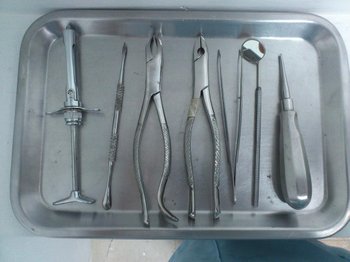
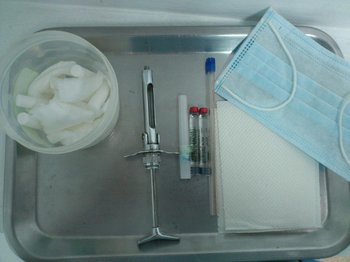
Teeth extracted:
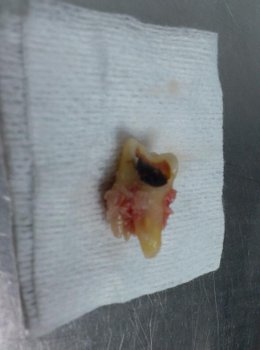
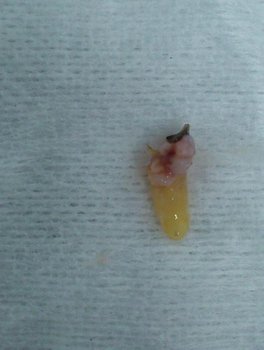
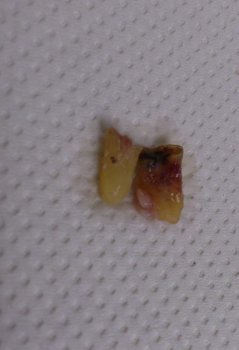
Note: All the photos that do not have a source are taken by myself.
Ref1 World Health Organization (1987): Oral health surveys. Basic Methods. 3rd. Geneve, Suiza, WHO.
Ref2, 3, 4 y 5 Etiologia de la Caries

I say goodbye with a simple, and very personal advice, do not neglect your teeth, because dental caries does not appear by magic, not from one day to another, if you take care of your oral health, you will prevent cavities from progressing until you turn your teeth into radicular remains. The art of Dentistry is to prevent.
I greet you dear community. Thanks for so much

wow what a amazing story
Heey gracias!!!! Aprecio mucho tu comentario, estare revisando tu blog! Saludos!!! Abrazos!!!
Great article! Thanks for shedding some light on a very painful topic.
If I like to share on these issues, to inform and educate people with the goal of taking care of their teeth! Greetings and thanks for your comment!!
Hola Isabel mi estimada amiga, es un artículo muy completo, didático y muy bien ilustrado sobre el tema dental.
Un fuerte abrazo desde Chile!!!